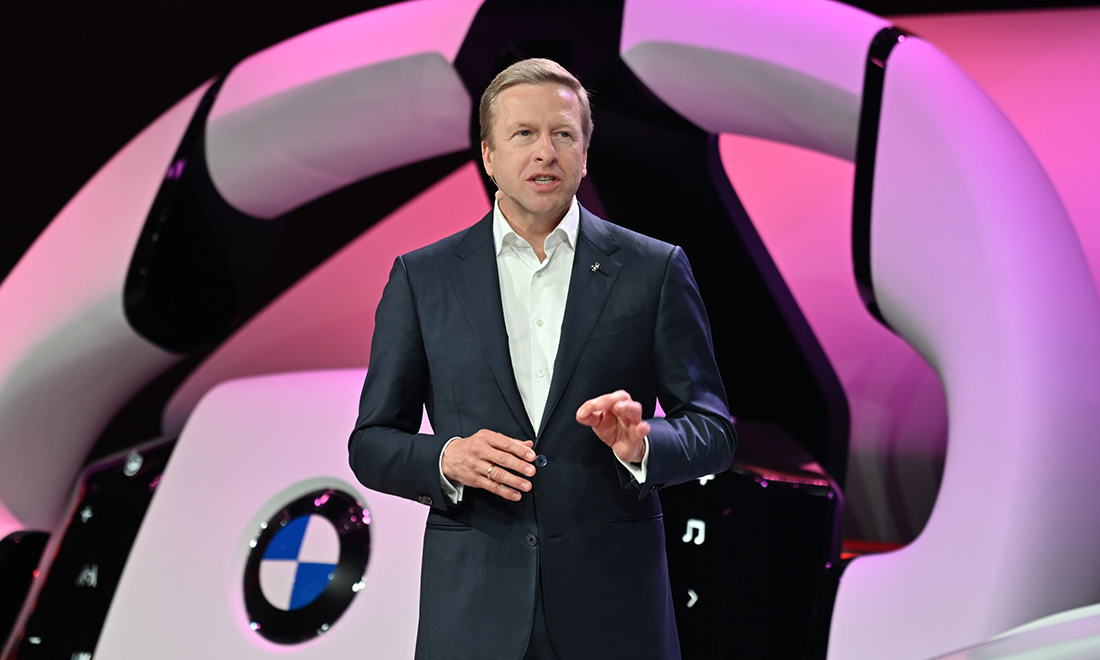
• 宝马公司首席执行官奥利弗·齐普策(Oliver Zipse)认为,尽管他正准备推出首款基于全新纯电动汽车专属平台的车型(后续还将推出数款),但宝马此前不愿跟风投身电动汽车领域的决策已得到验证。“即便面临巨大阻力,我们仍坚定立场。如今形势正朝着有利于我们的方向发展。”他说道。
市场研究公司Gartner将这一阶段称为“幻灭低谷”:一项热门新技术首次未能达到其炒作效果时所处的阶段。
宝马是最早预测电动车将经历发展阵痛的车企之一。多年来,这家德国豪华汽车制造商的高管一直警告称,尽管特斯拉掀起了行业热潮,但购车者转向电动车的速度不会如预期般迅速。
如今,宝马向股东表态,将坚守多元化动力系统战略,持续为消费者提供包括燃油车、混合动力车型以及2028年将首次亮相的氢燃料电池车在内的产品选择。
首席执行官奥利弗·齐普策在上周三举行的宝马年会上说:“技术开放意味着紧跟市场,因为市场在演变,但不同市场的发展步调并不一致。将电动化作为唯一技术路径只会走向死胡同。当前形势已充分表明了这一点。”
大约五年前,包括梅赛德斯-奔驰(Mercedes-Benz)、大众(Volkswagen)和沃尔沃(Volvo)在内的许多品牌均宣布了尽快向电动车转型的宏大目标。相比之下,宝马拒绝跟风电动车浪潮,曾招致大众前首席执行官赫伯特·迪斯(Herbert Diess)等竞争对手批评其拖慢行业进程。
齐普策表示:“即便面临巨大阻力,我们仍坚定立场。如今形势正朝着有利于我们的方向发展。”
2013年,宝马推出了适用于市内驾驶的小型电动车i3,但这款车型却让公司蒙受损失。该车型采用轻量化但成本高昂的碳纤维车身架构,本欲成为潮流标杆,却沦为分析师与投资者眼中的财务失败案例。
传统品牌难以说服消费者接受电动车优势
在本十年初,随着特斯拉风靡全球,首席执行官埃隆·马斯克(Elon Musk)忙于应对旺盛需求,这种电动车的宣传热潮看似合乎产业逻辑。2020年,特斯拉虽全年仅售出50万辆汽车,却超越所有汽车同行,成为全球市值最高的车企。
宝马的竞争对手已投入数十亿美元开发专用架构,以经济高效地制造各种尺寸和类型的电动汽车,如梅赛德斯-奔驰的EVA2和大众备受推崇的MEB平台。
但现实却给行业泼了一盆冷水。传统品牌难以向持怀疑态度的消费者阐述技术优势。车企抱怨称,围绕电动车仍有许多认知误区待澄清,包括车主在雨中充电是否会触电。
相比之下,特斯拉能够迎合那些渴望率先体验最新技术、熟知产品利弊的前卫受众。
如今,许多传统车企如梅赛德斯-奔驰和沃尔沃已着手调整激进的电动车销售目标。
新款iX3将于年底投产
电动车普及速度低于预期,特斯拉也未能幸免。去年,特斯拉放弃了2030年的销售目标,遭遇Model Y推出以来的首次年度销量下滑,且颓势持续到今年第一季度。
其一,在全球最大的电动车市场中国,这些品牌原本期望将其在传统燃油车市场的份额转移至电动车领域。就连特斯拉也从2024年的第三位跌至上个月的第八位。
其他国家,如美国,根本不愿再用每辆车7500美元的联邦税收补贴来资助购买更昂贵的电动汽车。欧洲市场对电动汽车的兴趣也不尽相同。
在石油资源丰富的挪威,几乎没有新车仍使用汽油或柴油,而在欧元区第三大经济体意大利,去年电动车在新车市场的份额仅为4%。
齐普策表示:“差异过于显著,甚至在欧洲内部亦是如此。”宝马集团(包括宝马、迷你和劳斯莱斯品牌)的全球电动车销量增长了14%,至超42.65万辆。
然而,就连这家慕尼黑汽车制造商也放弃了对电动专属平台的抵触——计划于今年年底在匈牙利投产的宝马iX3中型电动跨界车将基于全新纯电架构Neue Klasse打造。(财富中文网)
译者:中慧言-王芳
• 宝马公司首席执行官奥利弗·齐普策(Oliver Zipse)认为,尽管他正准备推出首款基于全新纯电动汽车专属平台的车型(后续还将推出数款),但宝马此前不愿跟风投身电动汽车领域的决策已得到验证。“即便面临巨大阻力,我们仍坚定立场。如今形势正朝着有利于我们的方向发展。”他说道。
市场研究公司Gartner将这一阶段称为“幻灭低谷”:一项热门新技术首次未能达到其炒作效果时所处的阶段。
宝马是最早预测电动车将经历发展阵痛的车企之一。多年来,这家德国豪华汽车制造商的高管一直警告称,尽管特斯拉掀起了行业热潮,但购车者转向电动车的速度不会如预期般迅速。
如今,宝马向股东表态,将坚守多元化动力系统战略,持续为消费者提供包括燃油车、混合动力车型以及2028年将首次亮相的氢燃料电池车在内的产品选择。
首席执行官奥利弗·齐普策在上周三举行的宝马年会上说:“技术开放意味着紧跟市场,因为市场在演变,但不同市场的发展步调并不一致。将电动化作为唯一技术路径只会走向死胡同。当前形势已充分表明了这一点。”
大约五年前,包括梅赛德斯-奔驰(Mercedes-Benz)、大众(Volkswagen)和沃尔沃(Volvo)在内的许多品牌均宣布了尽快向电动车转型的宏大目标。相比之下,宝马拒绝跟风电动车浪潮,曾招致大众前首席执行官赫伯特·迪斯(Herbert Diess)等竞争对手批评其拖慢行业进程。
齐普策表示:“即便面临巨大阻力,我们仍坚定立场。如今形势正朝着有利于我们的方向发展。”
2013年,宝马推出了适用于市内驾驶的小型电动车i3,但这款车型却让公司蒙受损失。该车型采用轻量化但成本高昂的碳纤维车身架构,本欲成为潮流标杆,却沦为分析师与投资者眼中的财务失败案例。
传统品牌难以说服消费者接受电动车优势
在本十年初,随着特斯拉风靡全球,首席执行官埃隆·马斯克(Elon Musk)忙于应对旺盛需求,这种电动车的宣传热潮看似合乎产业逻辑。2020年,特斯拉虽全年仅售出50万辆汽车,却超越所有汽车同行,成为全球市值最高的车企。
宝马的竞争对手已投入数十亿美元开发专用架构,以经济高效地制造各种尺寸和类型的电动汽车,如梅赛德斯-奔驰的EVA2和大众备受推崇的MEB平台。
但现实却给行业泼了一盆冷水。传统品牌难以向持怀疑态度的消费者阐述技术优势。车企抱怨称,围绕电动车仍有许多认知误区待澄清,包括车主在雨中充电是否会触电。
相比之下,特斯拉能够迎合那些渴望率先体验最新技术、熟知产品利弊的前卫受众。
如今,许多传统车企如梅赛德斯-奔驰和沃尔沃已着手调整激进的电动车销售目标。
新款iX3将于年底投产
电动车普及速度低于预期,特斯拉也未能幸免。去年,特斯拉放弃了2030年的销售目标,遭遇Model Y推出以来的首次年度销量下滑,且颓势持续到今年第一季度。
其一,在全球最大的电动车市场中国,这些品牌原本期望将其在传统燃油车市场的份额转移至电动车领域。就连特斯拉也从2024年的第三位跌至上个月的第八位。
其他国家,如美国,根本不愿再用每辆车7500美元的联邦税收补贴来资助购买更昂贵的电动汽车。欧洲市场对电动汽车的兴趣也不尽相同。
在石油资源丰富的挪威,几乎没有新车仍使用汽油或柴油,而在欧元区第三大经济体意大利,去年电动车在新车市场的份额仅为4%。
齐普策表示:“差异过于显著,甚至在欧洲内部亦是如此。”宝马集团(包括宝马、迷你和劳斯莱斯品牌)的全球电动车销量增长了14%,至超42.65万辆。
然而,就连这家慕尼黑汽车制造商也放弃了对电动专属平台的抵触——计划于今年年底在匈牙利投产的宝马iX3中型电动跨界车将基于全新纯电架构Neue Klasse打造。(财富中文网)
译者:中慧言-王芳
• BMW’s chief executive Oliver Zipse felt his company’s reluctance to jump on the EV bandwagon has been vindicated even as he prepares to launch his first of several models underpinned by an platform built from the ground up for EVs. “We took a clear stand on this, even in the face of strong headwinds. Now the wind has shifted in our direction,” he said.
Market research firm Gartner dubbed it the “trough of disillusionment”: the stage when a buzzy new technology first fails to live up to its hype.
One of the earliest to predict electric vehicles would suffer its own growing pains has been BMW. For years, executives at the German premium carmaker have been warning car buyers would not make the switch as quickly as anticipated, despite all the excitement around Tesla.
Now, it’s told shareholders it would stand by its commitment to offer customers a wide range of drivetrain options including combustion engine, hybrid, and even hydrogen fuel-cell powered cars, with the latter debuting in 2028.
“Technology openness means following the markets, because markets evolve, but not all a the same pace,” said CEO Oliver Zipse at BMW’s annual meeting on Wednesday. “E-mobility as the sole technology leads to a dead end. That should be obvious by now.”
Some five years ago, a number of brands including Mercedes-Benz, Volkswagen, and Volvo proclaimed ambitious targets for how soon they would switch to EVs. By comparison, BMW’s reluctance to jump on the EV bandwagon saw rivals like VW’s ex-CEO Herbert Diess criticize the company for slowing down progress.
“We took a clear stand on this, even in the face of strong headwinds. Now the wind has shifted in our direction,” Zipse continued.
BMW turned bearish on EVs after the company was burned by the i3, a small EV for inner-city driving that launched in 2013. Featuring a lightweight but expensive carbon-fibre body, it was supposed to be a trend setter, but ended up a financial failure in the eyes of analysts and investors.
Legacy brands struggled to convince their customer base of the advantages of EVs
At the start of the decade, this EV evangelizing seemed to make sense as Tesla was all the rage and CEO Elon Musk struggled to keep up with demand. In 2020, Tesla eclipsed all automotive peers to become the most valuable carmaker in the world despite selling only half a million vehicles that year.
BMW’s rivals had already poured billions into the development of dedicated architectures capable of economically building a wide variety of EVs in all shapes and sizes—such as the EVA2 at Mercedes-Benz and Volkswagen’s vaunted MEB platform.
The results have been sobering. Legacy brands have had a difficult time explaining the advantages of the technology to their skeptical customers. Carmakers have complained there are still plenty of popular myths around EVs that need to be debunked, including whether owners might be electrocuted while charging in the rain.
By comparison, Tesla could cater to a predominantly progressive audience eager to be the first to test out the latest that technology had to offer, and were well-versed about the various pros and cons.
Now, many of these same legacy companies such as Mercedes and Volvo have been walking back their more ambitious EV sales targets.
Start of production of new iX3 at year-end
The slower-than-expected uptake in EVs hasn’t left Tesla untouched either. Last year, it buried its own 2030 sales target, suffered its first annual sales decline since the Model Y launched, and saw its slump continue into the first quarter.
For one, the Chinese EV market, which is the world’s largest, is increasingly shutting out western brands that had expected to transfer their market share in the traditional combustion-engine market to the EV market. Even Tesla dropped to eighth place last month, from third in 2024.
Other countries like the United States are flat-out no longer willing to finance the purchase of a more expensive EV with a $7,500 per car federal tax subsidy. Europe also has experienced disparate levels of interest.
While few new cars sold in oil-rich Norway still require gasoline or diesel, in the euro area’s third-largest economy, Italy, the EV share of the new-car market languished at just 4% last year.
“The differences are too severe, even within Europe,” Zipse said, whose company’s own global EV sales grew by 14% to over 426,500 vehicles across the BMW, Mini, and Rolls-Royce brands.
Nevertheless, even the Munich carmaker has dropped its opposition to dedicated EV platforms. The BMW iX3 mid-size electric crossover, scheduled to go into production at the end of this year in Hungary, is based on the Neue Klasse, an all-new and EV-only architecture.






